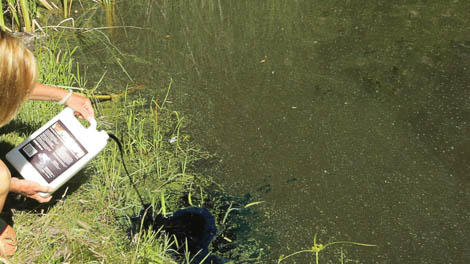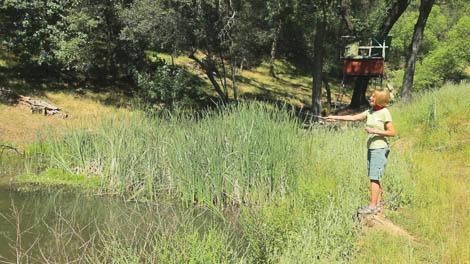Use a pond to raise fish for food on your property — we'll show you the simplest ways to stock your pond with fish you'd like to eat. As the University of Arkansas Extension so penetratingly observes, "Fish ponds are like other agriculture, just wetter." In our new video, Tricia visits Pete's pond in Nevada County and talks about the basics of pond design, planting, and adding fish.

Fishy Facts
Three species of fish do especially well in a one-acre (or larger) freshwater pond. A beginner’s easy strategy for stocking a pond is to add both Largemouth Bass and Bluegill. The Bluegills serve as food for the bass; both the Bluegill and the bass serve as food for the humans who fish the pond. For something different, try a catfish pond—or add catfish as the third species along with bass and Bluegill. The trio are:
-
Bass
- A popular, large predator fish, easy to catch, and helps control smaller fish populations. As the top predator in most ponds, the bass population can be managed through fishing.
-
Bluegill
- Young Bluegills are called bream and are enjoyed by both humans and bass alike.
-
Catfish
- If you crave catfish, try a pond stocked with only Channel Catfish. They can also be added as the third species alongside bass and Bluegill, but controlling predation can be more challenging.

A Fish Attraction Is an Amusement Park for Fish
If your world were an acre of water, you'd want some diversion too. A fish attraction is something you add to the pond to make the environment more interesting for fish — usually places to hide. Place the fish attraction close to where you will be fishing, since you might as well cast into a school of fish!
Too Much of a Good Thing
Ponds can get overrun with algae. As algae decomposes, it pulls oxygen from the water. You don't have to be an ichthyologist to have a healthy, fish-filled pond — just stick to the basics on stocking your pond with fish.

Too much of a good thing
Ponds can get overrun with algae. As algae decomposes, it pulls oxygen from the water. You don't have to be an ichthyologist to have a healthy, fish-filled pond — just stick to the basics on stocking your pond with fish.

1. Best Fish for Small Backyard Ponds
For ponds smaller than one acre, the best fish for small pond setups are hardy fish for small pond environments that adapt well to limited space. Popular types of fish in a pond include sunfish, tilapia (in warm climates, USDA zones 9-11), and hybrid bluegill.
When stocking a small pond with fish, choosing hardy fish ensures better survival and growth. These backyard pond fish are ideal for enthusiasts looking for low-maintenance, productive fish populations.
2. How Many Fish Should I Stock Per Acre?
For a balanced pond, start with approximately:
- 1,000 Bluegill
- 100 Largemouth Bass
- 100 Catfish per acre
This simple pond fish stocking chart provides guidance on how many fish per acre to add, helping maintain an ideal fish stocking density for healthy growth and a balanced ecosystem.
Keep in mind, actual stocking densities may vary depending on pond size, depth, vegetation, and management goals. Consulting local experts can help tailor stocking rates to your specific conditions.

3. When Is the Best Time to Stock a Pond with Fish?
The best time to stock pond fish is in the spring or fall, when water temperatures are moderate—typically between 50°F and 70°F. These conditions reduce stress on the fish, making it easier for them to acclimate, find food, and establish territories.
Avoid stocking during extreme heat or cold, as it can shock the fish and lower survival rates. For the most effective results, consult a trusted pond stocking guide to determine exactly when to add fish based on your local climate and pond conditions.
4. Where to Buy Fish for Pond Stocking
You can buy pond fish online or from trusted local sources. When deciding where to get pond fish, choose certified hatcheries or reputable farms that offer healthy, disease-free stock.
Searching for a "fish hatchery near me" is a great way to find fish well-suited to your region, helping you build a healthy and balanced pond ecosystem.
5. Pond Maintenance Tips for Healthy Fish
Wondering how to maintain fish pond conditions year-round? Follow these essential fish pond care tips:
- Regularly check oxygen levels and add pond aeration for fish if needed.
- Introduce aquatic plants to improve water quality and provide natural shade and shelter.
- Avoid overfeeding to prevent nutrient buildup, algae blooms, and poor water conditions.
Proper maintenance ensures a balanced pond environment where your fish can thrive throughout the year.

Conclusion
Raising fish in your own pond is a rewarding way to produce fresh food and support a healthy aquatic ecosystem. Whether you’re building a small backyard pond, managing a larger one-acre system, or integrating an aquaponic system, choosing the right species, following proper stocking guidelines, and practicing good pond maintenance are key. With smart planning and consistent care, you can enjoy a thriving fish population year-round.
FAQ: Aquaculture Pond Planning — Best Fish for Small Pond and Types of Fish in a Pond
-
What are the best fish for small backyard ponds?
- For ponds smaller than one acre, hardy fish like sunfish, tilapia (in warm climates), and hybrid bluegill are ideal. These species adapt well to limited space and are low-maintenance, making them perfect for small pond environments.
-
How many fish should I stock per acre in my pond?
- A balanced stocking ratio is approximately 1,000 Bluegill, 100 Largemouth Bass, and 100 Catfish per acre. This helps maintain a healthy ecosystem and promotes balanced fish growth.
-
When is the best time to stock fish in a pond?
- Spring and fall are the best times to stock fish, when water temperatures are moderate (typically between 50°F and 70°F). These conditions reduce stress on fish, improving their survival and adaptation.
-
Where can I buy healthy fish for pond stocking?
- Purchase fish from certified hatcheries or reputable local farms that provide healthy, disease-free stock. Searching for a “fish hatchery near me” can help you find fish suited to your regional climate.
-
How do I maintain a healthy pond for my fish?
- Maintain oxygen levels with aeration if needed, introduce aquatic plants for natural shade and water quality, and avoid overfeeding to prevent algae blooms and poor water conditions. Regular care ensures a balanced pond ecosystem.
-
Can I stock a pond with multiple fish species?
- Yes! A common strategy is to stock Largemouth Bass, Bluegill, and Channel Catfish together. Bluegills provide food for bass, and catfish add diversity. However, managing predation is important, especially with catfish in the mix.

